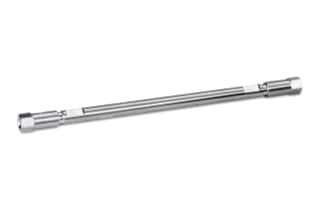
|
Chemistry |
Silica |
|
Separation Mode |
Normal-Phase |
|
Particle Substrate |
Silica |
|
pH Range Min |
2 pH |
|
pH Range Max |
8 pH |
|
Maximum Pressure |
6000 psi (415 Bar) |
|
Endcapped |
No |
|
Bonding Technology |
Silica |
|
Silanol Activity |
High |
|
Particle Shape |
Spherical |
|
Particle Size |
5 µm |
|
Endfitting Type |
Waters |
|
Pore Size |
90 Å |
|
Format |
Column |
|
Surface Area |
200 |
|
System |
HPLC |
|
USP Classification |
L3 |
|
Inner Diameter |
3.9 mm |
|
Length |
150 mm |
|
UNSPSC |
41115709 |
|
Brand |
Resolve |
|
Product Type |
Columns |
|
Units per Package |
1 pk |

Resolve Silica Column, 90Å, 5 µm, 3.9 mm X 150 mm, 1/pk
The non-end-capped Resolve packings differ greatly from Waters' other packing supplies. The polar molecules, which are often more retained, are the ones where the shift in chromatographic behavior is most frequently observed. Basic chemicals can be chromatographed utilizing mobile phase modifiers such as ion-pairing reagents, which reduce excessive tailing. High-resolution applications can use resolve C18 and silica columns, which are both available.
Liquid chromatography relies on accurate sample preparation, which is intended to deliver the target sample component in solution, free of interfering matrix components, and at a concentration suitable for detection or measurement. The Waters Resolve Silica Columns will continuously deliver excellent quality and the desirable results needed for liquid chromatography, so you can count on them. These columns are made in specialized, cutting-edge Waters facilities, much like all of their equipment. Silica-based and polymeric chromatography components are created at the manufacturing facility, then loaded into columns and solid-phase extraction equipment. This guarantees that you receive lab equipment of the highest caliber that produces trustworthy and consistent analytical findings. When you buy the Resolve Silica Column, you get the most important performance features: column efficiency, peak symmetry, column longevity, and column-to-column repeatability.
With the right lab equipment, you can boost your productivity. Visit our shop for lab equipment to find out more about the different versions of a given product, such as the Resolve Silica Column, or to locate complimentary items. You can browse our website and catalog to make sure your lab needs are covered and shop for lab equipment.
You should also review LCMS Certified Clear Glass 12 x 32 mm Screw Neck Vial, with Cap and Preslit PTFE/Silicone Septum, 2 mL Volume, 100/pk; All Waters LCMS Certified vials are produced following tightly controlled manufacturing processes and handling procedures. They are tested with mass spectrometers and come packaged with a certificate of analysis showing the reference and vial scan for the manufacturing lot.
What Does Chromatography Sensitivity Mean?
Sensitivity, which can be represented by the slope of a linear calibration curve, is the signal output per unit concentration or mass of a material in the mobile phase entering the detector. For concentration-sensitive detectors, sensitivity is also the relationship between peak height and analyte concentration in the peak. Peak height to unit mass is the ratio in mass-flow-sensitive detectors. Sensitivity must solely depend on the chemical measurement procedure and not on scale variables in order to constitute a distinct performance attribute. Numerous technical and chemical parameters influence an analyte's susceptibility to detection (that is, qualification) or measurement (that is, quantification).